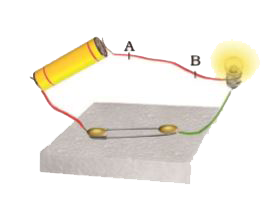When a current through the medium, an electric field exists as well as a potential which varies in space. Suppose that there is a break in a high - voltage transmission line and the free end of a wire of length L is lying on the ground. An electric current flows through the regions of soil adjoining the conductor. If a man happens to be walking near by a potential difference, which is called the step voltage appears between the points where his feet touch the ground, Consequently, an electric current whose strength depends on this potential difference flows through the man.
Let us calculate the step voltage. Since the conductor is quite long, we assume that the current flows from it to the ground in a direction perpendicular to the conductor. The equipotential surfaces are the surfaces of semi-cylinders whose axes coincide with the conductor. Suppose that the man is walking in a direction perpendicular to the conductor with a step of length 'b' the distance between the conductor and the foot closer to it being d. Assuming that the current flows uniformly from the conductor over the semi cylindrical region we obtain the following expression for the current density at a distance from the conductor:
j=iπrL
In this case , the field strength along the radii perpendicular to the conductor is Er=jσ=lπrLσ
Consequently , the step voltage is Vst=∫d+bdEdr=1πσLln(d+bd)
For example , If l=500A , d=1 m , b=65 cm and L=30 m we find that Vst=270 V. Much higher voltages may appear under other conditions and other shapes of conductors.
When a part of a high- voltage transmission line falls on the ground, it creates a hazard
because there can be a direct contact between the cable and a human being
because of the emergence of step voltages.
both (A) and (B)
none of (A) and (B)
The correct Answer is:C
Topper's Solved these Questions
- PHYSICS PART2BOOK - FIITJEECHAPTER - PHYSICS PART2EXERCISE - Numerical Based
4 Videos
- PHYSICS PART2BOOK - FIITJEECHAPTER - PHYSICS PART2EXERCISE - Numerical Based Question Decimal Type
6 Videos
- PHYSICS PART2BOOK - FIITJEECHAPTER - PHYSICS PART2EXERCISE - Assertion-Reasoning MCQ
12 Videos
- PHYSICS PART-IIIBOOK - FIITJEECHAPTER - PHYSICS PART-IIIEXERCISE - NUMERICAL BASED QUESTIONS DECIMAL TYPE
11 Videos
- ROTATIONAL MECHANICSBOOK - FIITJEECHAPTER - ROTATIONAL MECHANICSEXERCISE - COMPREHENSION - IV
2 Videos
Similar Questions
Knowledge Check
What happens when an electric current is passed through a wire?
AThe wire gets coolBThe wire gets gotCThe wire gets cool first and then gets hotDNo change occursThe flow of the electric current through a metallic conductor is
Aonly due to electronsBonly due to +ve chargesCdue to both nuclei and electrons.Dcan not be presictedA steady electric current is flowing through a cylindrical conductor. Then,
Athe electric field at the axis of the conductor is zeroBthe magnetic field at the axis of the conductor is zeroCthe electric field in the vicinity of the conductor is zeroDthe magnetic field in the vicinity of the conductor is zero
If the potential difference across the ends of a conductor is i volt and the current flowing through the conductor is 1 ampere,the resistance of the conductor?
View SolutionA current of 0.2 A flows through a wire whose ends are at a potential difference of 15 V. Calculate :
the resistance of the wire,
View SolutionA current of 5 amperes flows through a wire whose ends are at a potential difference of 3 volts. Calculate the resistance of the wire.
View SolutionThrough which of the following does electric current not flow ?
View SolutionWhen there is an electric current through a conducting wire along its length, then an electric field must exist
View Solution

